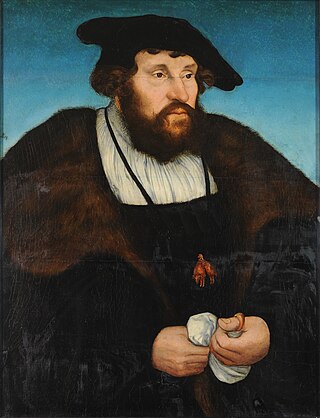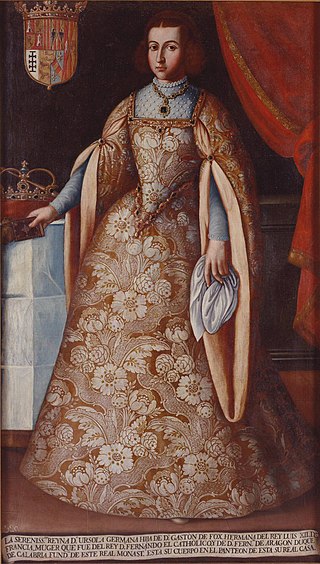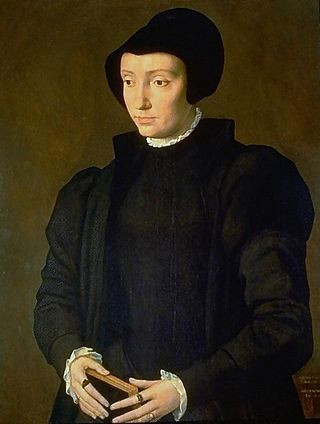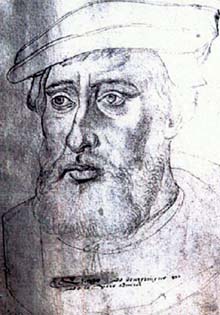
Joachim I Nestor was a Prince-elector of the Margraviate of Brandenburg (1499–1535), the fifth member of the House of Hohenzollern. His nickname was taken from King Nestor of Greek mythology.

John III was King of Sweden from 1569 until his death. He was the son of King Gustav I of Sweden and his second wife Margaret Leijonhufvud. He was also, quite autonomously, the Duke of Finland from 1556 to 1563. In 1581 he assumed the title Grand Prince of Finland. He attained the Swedish throne after a rebellion against his half-brother Eric XIV. He is mainly remembered for his attempts to close the gap between the newly established Lutheran Church of Sweden and the Catholic Church, as well as his conflict with and murder of his brother.

Christian II was a Scandinavian monarch under the Kalmar Union who reigned as King of Denmark and Norway, from 1513 until 1523, and Sweden from 1520 until 1521. From 1513 to 1523, he was concurrently Duke of Schleswig and Holstein in joint rule with his uncle Frederick.

Charles Brandon, 1st Duke of Suffolk was an English military leader and courtier. Through his third wife, Mary Tudor, he was brother-in-law to King Henry VIII.

Isabella of Austria, also known as Elizabeth, was born an Archduchess of Austria and Infanta of Castile from the House of Habsburg, and subsequently became Queen of Denmark, Norway and Sweden, under the Kalmar Union, as the wife of King Christian II. She was the daughter of King Philip I and Queen Joanna of Castile and the sister of Charles V, Holy Roman Emperor. She ruled Denmark as regent in 1520.

Dyveke Sigbritsdatter or Dyveke Willomsdatter,, in Denmark normally known as "Dyveke", was the mistress to Christian II of Denmark.

Theresa Kunegunda, was a Polish princess, Electress of Bavaria and of the Electorate of the Palatinate. By birth she was member of the House of Sobieski and by marriage member of the House of Wittelsbach. She also served as Regent of the Palatinate in 1704–05.

Ursula Germaine of Foix was an early modern French noblewoman from the House of Foix. By marriage to King Ferdinand II of Aragon, she was Queen of Aragon, Majorca, Naples, Sardinia, Sicily, and Valencia and Princess of Catalonia from 1505 to 1516 and Queen of Navarre from 1512 to 1516. She was Vicereine of Valencia from 1523 until her death in 1536, jointly with her second and third husbands, respectively Johann of Brandenburg-Ansbach and Ferdinand, Duke of Calabria. By her third marriage, she was Duchess of Calabria.
Mogens Gøye was a Danish statesman and Steward of the Realm, whose enormous wealth earned him the derogatory nickname "the King of Northern Jutland". Gøye was the Royal councillor of Danish Kings John I, the feuding Christian II and Frederick I, and Christian III. He was a key supporter of the Reformation in Denmark-Norway and Holstein. Often lauded by elder Danish historians as a knightly, social liberal upper-class idealist, Gøye is today viewed as a realist statesman understanding the need of a government and a moderate political attitude of the nobility.

Magnus Heinason was a Faroese naval hero, trader and privateer.
Cecilia Månsdotter Eka also called Cecilia of Eka, was a Swedish noblewoman. She was the spouse of Erik Johansson Vasa and mother of King Gustav I of Sweden.
Anna Jönsdotter, also known as Anna Pehrsönernas moder, was the mother of the Swedish politician Jöran Persson, the powerful adviser of king Eric XIV of Sweden. She was rumored to be a witch, and considered to have wielded a significant and disliked influence over her son and the affairs of state. She has been referred to by the name "Anna Pehrsönernas moder".

Elizabeth of Denmark, Norway, and Sweden was a Danish princess who became Electress of Brandenburg as the spouse of Joachim I Nestor, Elector of Brandenburg. She was the daughter of King Hans of Denmark, Norway and Sweden and his spouse, Christina of Saxony.

Torben Oxe was a Danish nobleman and a member of an aristocratic family.

Dorothea of Denmark and Norway was a Danish, Norwegian and Swedish princess and an electress of the Palatinate as the wife of Elector Frederick II of the Palatinate. She was a claimant to the Danish, Norwegian and Swedish thrones and titular monarch in 1559–1561.
Margaret Stewart was the younger daughter of James II of Scotland and Mary of Guelders. Once engaged to the Lancastrian Prince of Wales, Margaret instead became the mistress of William Crichton, 3rd Lord Crichton, and the mother of his illegitimate daughter, Margaret Crichton, later Countess of Rothes, and his son, Sir James Crichton, progenitor of the Viscounts of Frendraught. Margaret and Lord Crichton may have been married later, after the death of Crichton's wife.
Anne Lykke was a Danish noblewoman and royal mistress of Christian, Prince Elect of Denmark.

Anne Meinstrup (1475–1535) was a politically active Danish noblewoman, lady-in-waiting and county administrator.

Adolf of Burgundy (1489–1540) was Lord of Veere and admiral of the Netherlands.
Elizabeth Barlay or Barlow was an English lady in waiting to Margaret Tudor the wife of James IV of Scotland.















